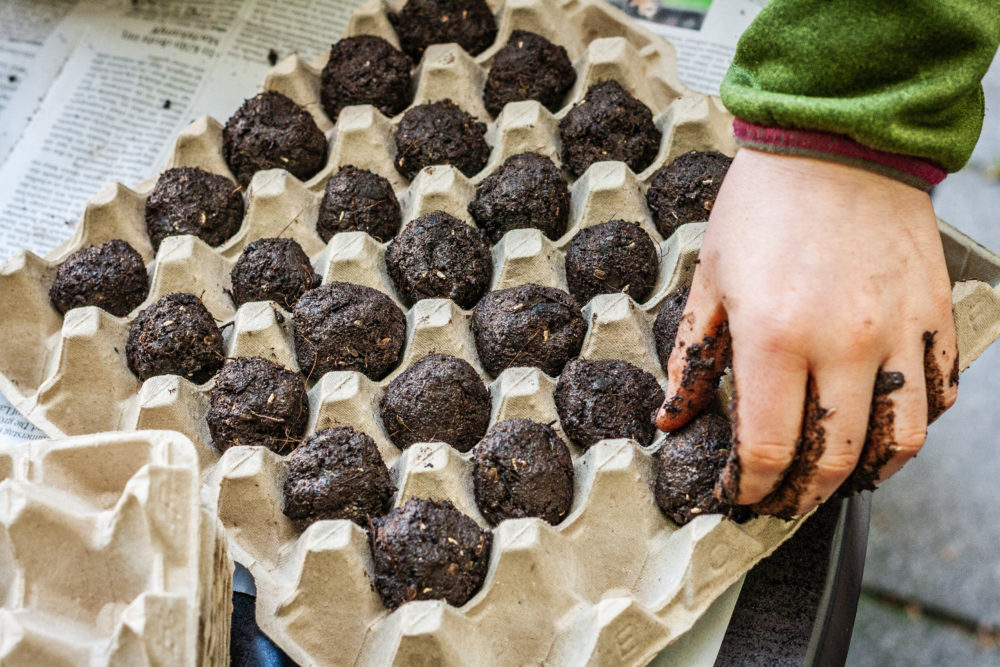For Earth Day (or any day) – Make a Seed Bomb!

We’ve been staying indoors to stay safe, children are learning remotely, and any space feels smaller and too familiar when it’s the only space we can occupy. Here’s an indoor garden activity to spark some creativity and make you think beyond the four walls. Make a seed bomb! It allows us to feel more invested in wildflowers, for both their fragrant blossoming and in Robert Frost’s words, for the beauty of their “tall tufts of flowers, their leaping tongues of bloom.” Let their role in ecosystems that include bees, butterflies, wasp, and birds be nourishing for us too!
Anyone whose made seed bombs before can tell you that before you go launching wildflower seed projectiles, you must start with a solid recipe. May Toy, one of CCGA’s most reliable and informative gardeners, has provided us with two great recipes that use materials that are commonly available. Most people already have this stuff without having to go out and buy or order a clay powder. Your choice of seed packets should be guided by what grows best in our region. Native, wildflower mixes or single packets and native seeds shared among gardeners are best. You should be aware that some of the native seeds may not germinate until the second year after you disperse them, and most of them will not bloom until their second or third year of growing, but these are seeds that do not dry out. Choose seeds like anemone, aster, or tick clover for more immediate blooms. Quick growing annuals like zinnia, cosmos and calendula are wonderful for seed bombs, and these will captivate pollinators. Remember seed size is important too. If you put sunflower seed in with a tiny orange butterfly milkweed, guess which one will dominate?
Flour Seed bombs
Materials
1 cup compost OR potting soil & compost mixture
1/2 cup of flour
1 tsp of seeds (or 1/2 tsp for very small seeds)
Instructions
1) First mix the compost and the flour together thoroughly.
2) Then add seeds and gently mix together
3) Add water one tablespoon at a time so that the mixture bonds together like a good dough. (Add more compost if mixture is too wet).
4) Once the mixture has the right consistency, divide mixture into small pieces and roll into a ball (small marble). A smaller seed ball is much more likely to have better contact with the soil and as the small ball crumbles it provides the start for the root system, but is still heavy enough to anchor the emerging seeds to the ground.
5) Let dry overnight or for 24 hours.
6) It’s best to lob, not throw overhand or place in a bare, neglected area where you want the seeds to grow right before rain is expected.
Paper Seed Bombs
Any type of paper can be used as long as it’s not glossy or coated. Construction paper, tissue paper, and newspaper work well. In honor of Earth Day, make Earth shape seed bombs, by using blue, white and green color papers.
Materials
3 cups or containers
3 sheets of construction or tissue paper (1 blue, 1 green, and 1 white)
3 packages of flower seeds (smaller seeds work better for paper seed bombs). You can use different types of flower seeds or a wildflower seed mixture works well.
You will need a blender and a strainer
Instructions
1) Cut each sheet of color paper into 1-inch squares and add 1.5 to 2 cups of water; blend until the paper is pulverized to make paper pulp.
2) Pour mixture out over strainer to drain
3) Squeeze water out of the mixture and put in a separate container. Should not be dripping wet.
4) Repeat steps 1 to 3 for each color paper
5) Add one package of seeds to each container of paper pulp and gently mix
6) Take a small amount of the pulp & seed mixture from each container and form it into a ball to resemble the Earth. If using other colors, you can also press it into a soap or candy mold.
7) Let dry on a cookie sheet or tray for 24 to 48 hours.
8) Lob or place in a garden area where you want the seeds to grow right before rain is expected. You can also plant in a planter depending on the type of flower seed.
